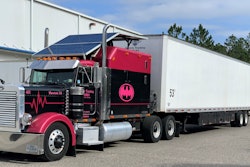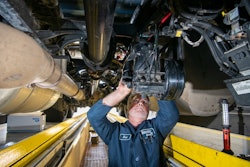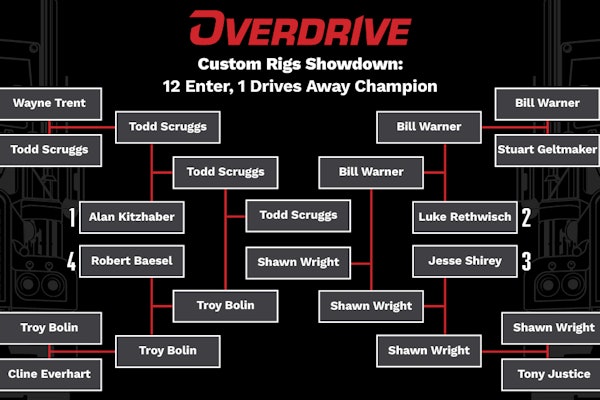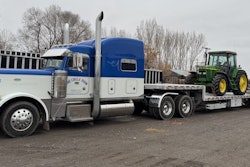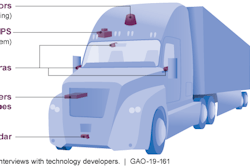 New Mexico-based Mesilla Valley Transportation, one of the nation’s leading innovators adopting fuel-saving technology, two years ago bought 1,000 eNow solar energy systems for its tractors. The systems use solar panels installed on MVT’s tractors to boost fuel economy and battery life and to power APUs.
New Mexico-based Mesilla Valley Transportation, one of the nation’s leading innovators adopting fuel-saving technology, two years ago bought 1,000 eNow solar energy systems for its tractors. The systems use solar panels installed on MVT’s tractors to boost fuel economy and battery life and to power APUs.One of the quickest ways to reduce a truck’s operating costs is to get its energy for free. Of course, no one’s giving away diesel fuel, but harnessing free sunlight is one way to conserve energy while upgrading your battery system.
Solar products also reduce emissions and decrease waste, said Paul Kroes, Thermo King’s North America strategic insights leader. All these benefits can be achieved without significant upfront investment.
A truck owner “can achieve rapid payback by installing 100 watts or less of solar power,” Kroes said. “Even a small 40-watt panel can generate 120 to 200 watts per day, which can fit into a 1 foot-by-2-foot space and can directly charge a 12- or 24-volt battery system.”
It’s difficult to calculate how much sun exposure a truck will need to see an improvement in energy usage, said Bob Doane, eNow’s vice president and chief technology officer. Factors include total wattage of the solar energy system (higher is better), type of charge controller (MPPT is superior to PWM), battery state of health, type of batteries (flooded lead-acid or AGM), number of batteries (four for electric auxiliary power units, up to three for liftgates), other charging sources (alternator or trailer charger) and the application’s power demands.

“Most applications will see a reduction in operating and maintenance costs,” Doane said. “However, based on the factors noted above, the rate of payback will vary from a few months to a couple of years. After the payback is reached, the savings go right to the company’s bottom line and run for many years.”
The most common trucking application for solar panels comes in support of auxiliary climate control and in-cab power systems that reduce the need to idle the engine during extended down periods, according to a report last year from the North American Council for Freight Efficiency. Mike Roeth, NACFE’s executive director, said battery HVACs were a viable but limited anti-idle solution.
“One of the most significant opportunities for solar is to extend the capabilities of battery powered APUs, which struggle to last the entire duration of a driver’s 10-hour rest period, especially in hot sunny weather,” Kroes added. “Solar panels are very effective at offsetting reduced runtime, because they add additional power back into the system. Solar panels ensure all batteries become fully charged to ensure the APU will provide its maximum potential during the next rest period.”
Solar panels used in support of an electrical system also help extend the life of the batteries, a key benefit noted in NACFE’s report.
“Properly designed solar systems constantly monitor battery voltage and battery temperature and charge the batteries based on that data,” Doane said. “This ensures the batteries are maintained in an optimal state of charge and not under- or overcharged.”
Doane said field tests have shown that eNow solar-based battery charging systems have proven to extend battery life by two to three years.
Kroes said early battery failure usually happens when batteries sit in a deeply discharged state, such as when equipment is parked for extended periods, such as a long weekend.
“Undercharging batteries, especially in cold weather, causes sulfidation of plates and robs life and capacity of the batteries,” Doane said. “Lead-acid batteries dislike being discharged more than 50%. Overcharging batteries causes excess gassing and the electrolyte to boil off, also reducing life and capacity.”
Doane said for all solar applications, a properly designed solar-based battery charging system reduces battery replacement and maintenance costs simply by extending battery life, saving labor costs for removal and installation of batteries.
In its report, NACFE also found having solar power helped avoid use of emergency roadside assistance and the downtime associated with dead batteries. “Other cost savings include reductions in penalties for late deliveries and municipality anti-idling fines,” Doane said.
The top of the trailer generally is not prone to impact, but low-hanging limbs and equipment used to remove snow and ice eventually are going to scrape trailer roofs. For that reason, most quality solar panels have a protective outer layer.
“Should there be damage to an individual cell from a sharp object, it will not affect the rest of the cells in the panel,” Doane said, noting there are 72 cells in eNow’s 310W panel.
Kroes said solar panels designed for the transportation industry also tend to be thin and flexible, suitable for installing on a curved roof. Thermo King’s ThermoLite panels are peel-and stick, requiring no holes to be drilled for installation, he said.
Kroes and Doane agreed that the panels themselves are largely maintenance- free, aside from an occasional washing, or dusting to remove ice or snow.
“If snow has accumulated on top of the panel, the preferred method of cleaning it off is to use a brush or broom,” Doane added. “Once the panel is exposed to the sun, it will warm up and tend to melt further accumulation, under one inch.”
Another tool to reduce electrical demand
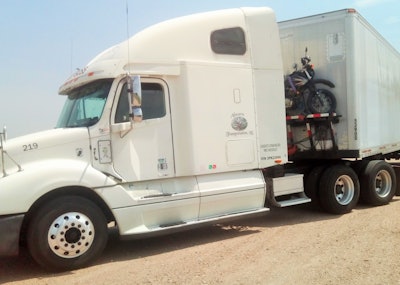 “I believe in being redundant,” said Kenny Capell, referring to his options for electric power sources as well as for ways to get around while away from home. He totes his motorbike on a van-mounted platform. Using a modified crane and winch, he can load and unload the two wheeler quickly.
“I believe in being redundant,” said Kenny Capell, referring to his options for electric power sources as well as for ways to get around while away from home. He totes his motorbike on a van-mounted platform. Using a modified crane and winch, he can load and unload the two wheeler quickly.Independent Kenny Capell already has modified his 2003 Freightliner Columbia to reduce electrical demand on its Detroit engine, but he’s hardly done. Among the next modifications: using solar power to get close to a “never-idle” status.
Capell estimates his investment in solar will be close to $5,000, “which is still half of an APU.” Not only can he forego paying for an auxiliary power unit, its installation and maintenance, but he also thinks he might recoup the solar investment in as few as six months from reduced diesel consumption.
Capell, who’s based in East Tennessee, hopes to have the system in place before next year’s heat arrives, and he has the components in hand. He has five 230-watt solar panels, each about 4 x 2.5 feet, to mount atop his dry van, though he said he might not need all five. A solar control box will route power from the panels to the batteries while guarding against overcharging.
A 3,000-watt inverter will power his hotel loads. Capell recommends using a pure sine wave inverter that helps protect certain appliances, especially those with digital readouts such as some coffeemakers. “That’s something we discovered last summer when my wife was out with me,” he said. “We ruined two of our crockpots.”
To further reduce the engine power demand for running his A/C, “I have an electric air conditioning compressor I’m going to incorporate, and I’m going to do away with the belt driven compressor.” As for reduced-idle heating, Capell plans to get a bunk heater.
 Kenny Capell
Kenny CapellHe’s already replaced a belt-driven engine fan with a unit of four electric fans that runs off battery power. The truck has optimized idle, which he reprogrammed, “so at night, when solar’s not there, if the batteries run down, it will crank automatically for 30 minutes instead of running for hours,” he said.
Capell’s also considering adding four batteries to the four existing ones, “just to have an extra standby load,” and possibly a start capacitor that “stores enough charge to crank the truck.”
“I’m looking at the idea of not having to idle the truck hardly at all,” he said. That should bring his loaded fuel mileage into the 8 or 9 mpg range.
For owner-operators who might want to explore the solar setup he’s planning but lack the technical expertise to rig it up, Capell points to YouTube tutorials. Truck owners who’d prefer to pay for the service, he said, often take their rigs to an RV shop. -Max Heine
